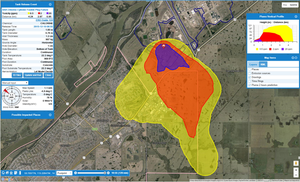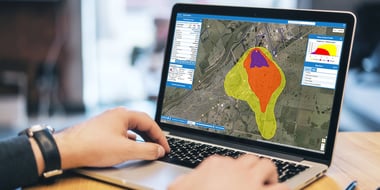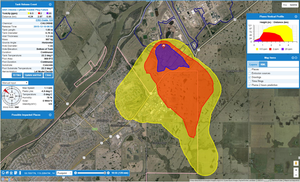A plant-wide power outage in Texas at Pasadena Refining Systems one hot July day forced the plant to flare off some product, including sulfur dioxide. As the toxic black smoke drifted into the nearby community, safety officials partially shut down the Houston Ship Channel and issued a precautionary shelter-in-place alert to protect area residents.
Fortunately, no injuries were reported as a result of this sulfur dioxide release, but the incident serves as a reminder that preparedness includes knowing that events beyond your control can and will happen. No amount of operational excellence, operator training, or reliability and maintenance could have stopped this event—that’s why it’s so critical to be prepared for any emergency.
During unplanned chemical releases, there are bound to be more questions than answers. You’ll ask yourself things like: What’s happening on the ground? What gas is being released? How much was released and where is it going? Will my employees, responders, and neighbors be exposed to dangerous levels of gas, and when will that happen? Where should I focus my emergency team to ensure an efficient response? Is it safe to shelter-in-place or should I order an evacuation? When can I say it’s safe?
Plume models are the best way to answer these questions and more.
What is Plume Modeling?
Plume models are also known as atmospheric plume dispersion models. They are software-based algorithms that calculate the path and concentrations of airborne contaminants.
 Some plume modeling software incorporates real-time data from gas and weather sensors into advanced algorithms. This tells you what contaminant is being released, where it’s coming from, and where the plume or cloud is going. With this information, you can identify the hazard zone and affected areas within a two-hour window. This allows you to make quick safety decisions for plant personnel. You can immediately notify first responders and arm them with the information they need to set up roadblocks, evacuation centers, command posts, as well as decontamination, triage, and staging areas.
Some plume modeling software incorporates real-time data from gas and weather sensors into advanced algorithms. This tells you what contaminant is being released, where it’s coming from, and where the plume or cloud is going. With this information, you can identify the hazard zone and affected areas within a two-hour window. This allows you to make quick safety decisions for plant personnel. You can immediately notify first responders and arm them with the information they need to set up roadblocks, evacuation centers, command posts, as well as decontamination, triage, and staging areas.
Plume modeling software allows you to stop estimating the gas dispersion path so you can take the right steps and operate with confidence during a chemical emergency.
You can also use plume models to plan and prepare for future scenarios. You can collect historical gas and weather data to explore if a plant-wide power outage would require you to flare off product. If you had to do this, what gases would be released? Where would they disperse? When would you need to notify local authorities? Would you need to evacuate nearby homes? Would you need to close roads near your facility? Asking these questions in advance gives you the power to create an emergency response plan, so you can be better prepared in case of an actual emergency.
Who Should Use Plume Modeling?
Plume modeling software benefits many industries and applications. This includes industrial plants, chemical storage facilities, pulp and paper mills, and emergency response scenarios.
Plume modeling makes perhaps the greatest impact in emergency response scenarios. During a chemical emergency, first responders must often make critical decisions with little to no information. From fires to chemical spills, plume models can help emergency responders understand the impact on the community to respond quickly and make safe decisions around evacuation and shelter-in-place alerts.
Which is Right for You: Static or Dynamic Plume Modeling?
Most facilities that are at risk for chemical incidents rely on some form of static plume modeling tool. ALOHA, the hazard modeling program from the Environmental Protection Agency, is one of the most common static plume modeling tools.
Static models are commonly used to maintain compliance with EPA regulations. These models calculate how fast the chemical is escaping, predict how that rate might change over time, estimate the areas of impact, and allow you to model different hazard types and release scenarios.
In order to create a plume with a static model, you must manually enter all of the necessary data points. In some cases, this information may not be available, so you must rely on your best estimate. Because of this, the plume generated by a static model will never be up to date.
Dynamic plume modeling tools like SAFER One® expand on static plume models by incorporating real-time gas and weather data. This gives you more accurate, up-to-date, and detailed information. Dynamic plume modeling software puts you in control by allowing you to monitor, model, and mitigate chemical releases.
Dynamic models incorporate real-time data from on-site gas and weather sensors. This generates an accurate plume model, then tracks and monitors all aspects of a chemical release in one place from start to finish. With live data on the size, speed, and path of the hazard, you can see the impact in an instant—both on your site and within your community—and what action you need to take to reduce risk. Whether it’s a chemical leak, derailment, or some other loss of containment, dynamic models have the power to immediately identify the problem.
In the event of a chemical release, responders often face an “information gap” where they must wait for answers. Knowing where the release occurred and having a system that monitors the facility answers most of these questions.
Using Dynamic Plume Models
Implementing and deploying dynamic plume modeling tools to monitor muster points, evacuation areas, the facility fence line, and community locations for hazardous airborne substances is the foundation for strong emergency response.
Using these real-time tools takes the guesswork out of mapping the dispersion of a chemical release, allowing facilities and first responders to react and make decisions with confidence, both inside your facility and in the communities you serve.
To learn more about how dynamic plume modeling can protect your people, plant, and community, download our eBook: How to Use Dynamic Plume Modeling for Safer Worksites and Communities.



